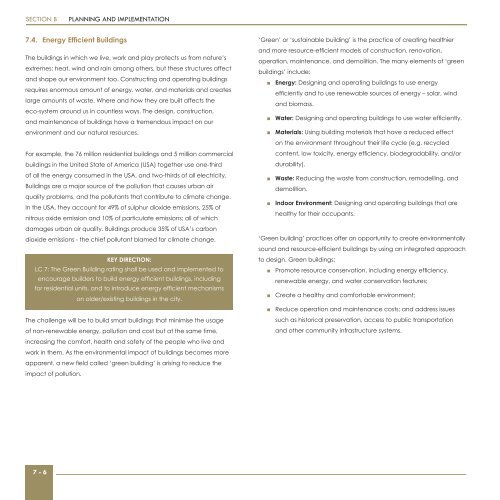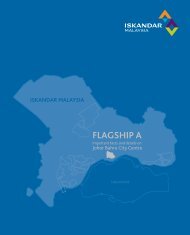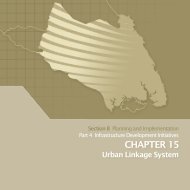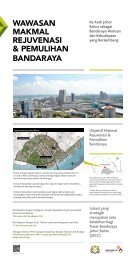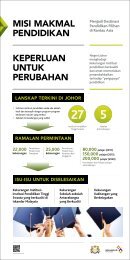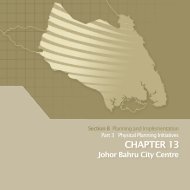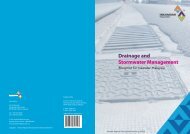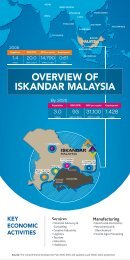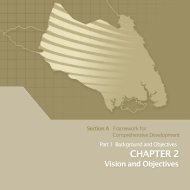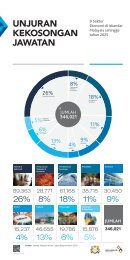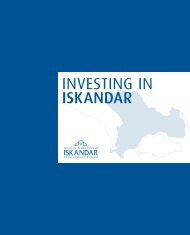Liveable Communities - Iskandar Malaysia
Liveable Communities - Iskandar Malaysia
Liveable Communities - Iskandar Malaysia
You also want an ePaper? Increase the reach of your titles
YUMPU automatically turns print PDFs into web optimized ePapers that Google loves.
SECTION B<br />
PLANNING AND IMPLEMENTATION<br />
7.4. Energy Efficient Buildings<br />
The buildings in which we live, work and play protects us from nature’s<br />
extremes; heat, wind and rain among others, but these structures affect<br />
and shape our environment too. Constructing and operating buildings<br />
requires enormous amount of energy, water, and materials and creates<br />
large amounts of waste. Where and how they are built affects the<br />
eco-system around us in countless ways. The design, construction,<br />
and maintenance of buildings have a tremendous impact on our<br />
environment and our natural resources.<br />
For example, the 76 million residential buildings and 5 million commercial<br />
buildings in the United State of America (USA) together use one-third<br />
of all the energy consumed in the USA, and two-thirds of all electricity.<br />
Buildings are a major source of the pollution that causes urban air<br />
quality problems, and the pollutants that contribute to climate change.<br />
In the USA, they account for 49% of sulphur dioxide emissions, 25% of<br />
nitrous oxide emission and 10% of particulate emissions; all of which<br />
damages urban air quality. Buildings produce 35% of USA’s carbon<br />
dioxide emissions - the chief pollutant blamed for climate change.<br />
KEY DIRECTION:<br />
LC 7: The Green Building rating shall be used and implemented to<br />
encourage builders to build energy efficient buildings, including<br />
for residential units, and to introduce energy efficient mechanisms<br />
on older/existing buildings in the city.<br />
The challenge will be to build smart buildings that minimise the usage<br />
of non-renewable energy, pollution and cost but at the same time,<br />
increasing the comfort, health and safety of the people who live and<br />
work in them. As the environmental impact of buildings becomes more<br />
apparent, a new field called ‘green building’ is arising to reduce the<br />
impact of pollution.<br />
‘Green’ or ‘sustainable building’ is the practice of creating healthier<br />
and more resource-efficient models of construction, renovation,<br />
operation, maintenance, and demolition. The many elements of ‘green<br />
buildings’ include:<br />
■ Energy: Designing and operating buildings to use energy<br />
efficiently and to use renewable sources of energy – solar, wind<br />
and biomass.<br />
■ Water: Designing and operating buildings to use water efficiently.<br />
■ Materials: Using building materials that have a reduced effect<br />
on the environment throughout their life cycle (e.g. recycled<br />
content, low toxicity, energy efficiency, biodegradability, and/or<br />
durability).<br />
■ Waste: Reducing the waste from construction, remodelling, and<br />
demolition.<br />
■ Indoor Environment: Designing and operating buildings that are<br />
healthy for their occupants.<br />
‘Green building’ practices offer an opportunity to create environmentally<br />
sound and resource-efficient buildings by using an integrated approach<br />
to design. Green buildings:<br />
■ Promote resource conservation, including energy efficiency,<br />
renewable energy, and water conservation features;<br />
■ Create a healthy and comfortable environment;<br />
■ Reduce operation and maintenance costs; and address issues<br />
such as historical preservation, access to public transportation<br />
and other community infrastructure systems.<br />
7 - 6


